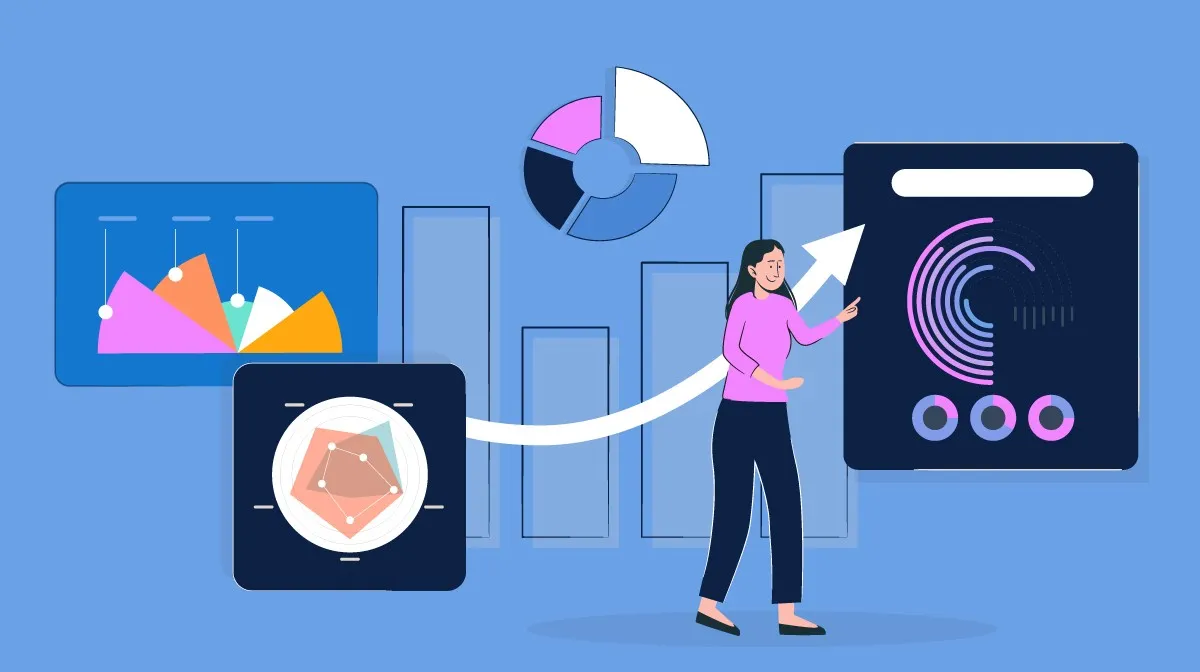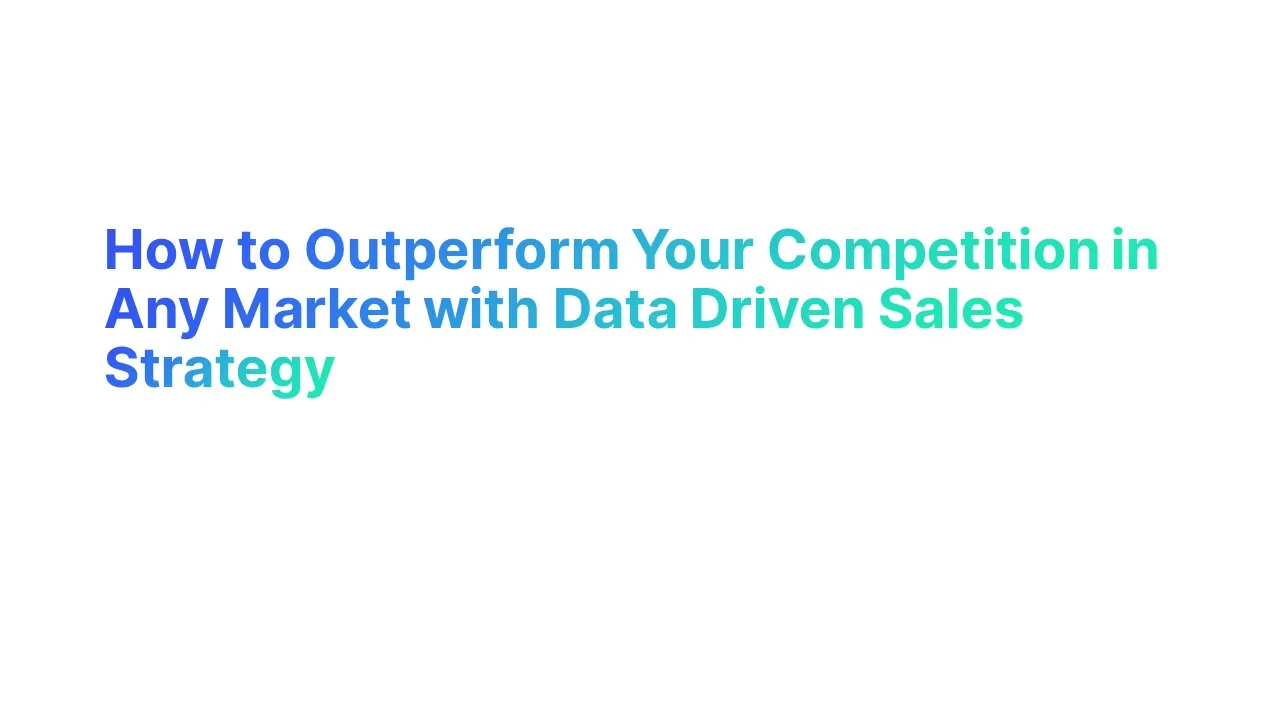Introduction to Data Driven Sales

What is Data Driven Sales?
Data driven sales refers to the strategic use of data to guide decision-making processes in sales operations, aiming to increase efficiency, productivity, and profitability. This approach leverages various data types, such as customer interactions, sales performance metrics, and market trends, to tailor sales efforts more effectively.
- Customer Insights: Utilizing data to understand customer preferences, behaviors, and needs to tailor sales pitches and offers.
- Sales Forecasting: Applying historical sales data and predictive analytics to anticipate future sales trends and customer demands.
- Performance Tracking: Monitoring sales metrics and KPIs to assess the effectiveness of sales strategies and team performance.
For example, a company like Amazon uses data analytics to recommend products based on previous browsing and purchasing patterns, significantly boosting their cross-selling and up-selling effectiveness.
Why You Need a Data Driven Sales Strategy to Outperform Competition

In today's highly competitive market, a data driven sales strategy is not just beneficial; it's crucial for staying ahead. Here’s why:
- Targeted Marketing Efforts: By analyzing sales data, companies can identify the most lucrative market segments and tailor their marketing efforts accordingly. For instance, Netflix uses viewing data to not only recommend movies and shows but also to decide which new series to produce.
- Improved Customer Retention: Data analysis helps businesses predict customer churn and develop retention strategies proactively. Companies using advanced analytics have seen up to a 15% increase in retention rates, according to a report by McKinsey.
- Optimization of Sales Processes: Data enables organizations to streamline operations, reduce costs, and enhance the customer buying experience. For example, Dell monitors social media data in real-time to detect and resolve issues faster, enhancing customer satisfaction.
- Enhanced Decision Making: With real-time data at their fingertips, sales leaders can make informed decisions quickly, adapting to market changes with agility. A study from the Harvard Business Review highlighted that organizations driven by data-driven decisions see a 5-6% increase in productivity and profitability over competitors.
Types of Data a Sales Team Should Track

To maximize the effectiveness of a data-driven sales strategy, it's crucial for sales teams to track a comprehensive range of data types. Here’s a breakdown of essential data categories that sales teams should monitor:
Customer Data
Understanding your customers is foundational in tailoring sales strategies that resonate and convert.
- Demographics: Includes age, gender, occupation, and location. This helps in segmenting the market and personalizing sales pitches.
- Psychographics: Information on customer lifestyles, values, and interests that aid in crafting compelling marketing messages.
- Purchase History: Records of past purchases can predict future buying behaviors and identify opportunities for upselling and cross-selling.
Sales Performance Data
Tracking sales performance data is vital for assessing the effectiveness of sales strategies and making necessary adjustments.
- Sales Volume: Measures the number of units sold in a specific period. It helps in identifying trends and forecasting future sales.
- Revenue Figures: Total revenue generated from sales activities. This data is crucial for evaluating the financial impact of sales efforts.
- Conversion Rates: The percentage of prospects who turn into customers. High conversion rates often indicate effective sales tactics.
Interaction Data
Every interaction with a customer provides insights that can enhance the sales process.
- Engagement Rates: Metrics from emails, social media, and websites show how customers interact with content and promotions.
- Service Touch Points: Includes data from customer service interactions which can reveal common concerns or issues faced by customers.
- Feedback and Surveys: Direct insights from customers about their satisfaction and product/service expectations.
Market and Competitive Data
Keeping an eye on the broader market and competitive landscape helps in staying ahead.
- Market Trends: Current events and developments in the industry that may affect sales strategies.
- Competitor Performance: Sales figures, marketing strategies, and product launches by competitors.
- Economic Indicators: Broader economic data such as consumer spending habits and economic growth rates that impact sales.
Operational Data
Efficient operations support effective sales strategies by ensuring resources are used optimally.
- Sales Cycle Length: The average time it takes to close a deal. Shorter cycles often indicate a more efficient sales process.
- Inventory Levels: Helps in managing supply chain effectively to meet customer demand without overstocking.
- Resource Allocation: Tracking how resources are distributed among different sales activities to optimize spending and manpower.
Lead and Opportunity Data
Understanding the journey from lead to customer is crucial for optimizing conversion strategies.
- Lead Source: Identifies where the most valuable leads are coming from, helping to optimize marketing spend and focus.
- Opportunity Win Rate: The percentage of sales opportunities that convert to actual sales, useful for evaluating the effectiveness of sales pitches and approaches.
- Time to Conversion: The duration from lead acquisition to sale closure, important for streamlining the sales process.
Communication Data
Analyzing communication patterns can reveal insights into customer preferences and the effectiveness of communication strategies.
- Email Open and Response Rates: Metrics from email campaigns that help assess the effectiveness of email content and timing.
- Call Data: Details from sales calls, including duration, frequency, and outcomes, to evaluate the impact of direct communication.
- Social Media Interactions: Insights from social platforms that indicate customer sentiment and engagement levels.
Sales Team Efficiency Data
Tracking the performance and efficiency of the sales team is essential for identifying areas for improvement and ensuring alignment with overall business goals.
- Individual and Team Quotas: Monitoring individual and team targets versus achievements to identify high performers and areas needing support.
- Activity Metrics: Number of calls made, emails sent, meetings held, which are indicative of team productivity and operational efficiency.
- Training and Development Impact: Assessing how training programs affect sales performance and skills enhancement.
Customer Retention and Loyalty Data
Retaining existing customers and fostering loyalty are as crucial as acquiring new customers.
- Retention Rates: The percentage of customers that continue to do business over a specific period.
- Customer Lifetime Value (CLV): The total revenue a business can expect from a single customer account throughout their relationship.
- Repeat Purchase Rate: The frequency with which customers return to purchase again, an indicator of customer satisfaction and product/service relevance.
Technological and Innovation Data
In a rapidly changing digital landscape, tracking how sales technologies and innovations are adopted can provide a competitive edge.
- Adoption Rates of New Tools: How quickly and effectively new sales technologies are adopted by the team.
- Innovation Impact: Assessing the impact of new sales methodologies or technologies on overall sales performance.
- Digital Engagement Metrics: Usage statistics of digital tools and platforms by both sales teams and customers.
External Market Factors
Factors outside the company’s control can significantly impact sales, making it essential to monitor these closely.
- Regulatory Changes: New laws and regulations that could affect sales practices or product offerings.
- Geopolitical Factors: Changes in the political landscape that may influence market conditions or supply chains.
- Consumer Sentiment Indices: Overall consumer confidence and sentiment, which can predict buying behaviors.
How to Create a Data Driven Strategy for Your Sales Process

Creating a data-driven strategy for your sales process involves systematically integrating data at every stage to make informed decisions that enhance performance and drive revenue. This approach not only helps in understanding customer behaviors and market trends but also optimizes sales operations and strategies. Here’s a step-by-step guide to developing an effective data-driven sales strategy:
1. Define Clear Objectives and Goals
Begin by establishing clear, measurable objectives for what you aim to achieve with your data-driven sales strategy. These objectives could range from increasing sales conversion rates, shortening the sales cycle, enhancing customer retention, or growing the average deal size.
- Align objectives with overall business goals to ensure coherence in strategy across the organization.
- Set specific, measurable targets (SMART goals) to facilitate tracking and adjustments.
2. Collect Relevant Data
The foundation of a data-driven strategy is the collection of high-quality, relevant data. Determine the types of data necessary to inform your sales decisions, including customer data, sales performance data, market trends, competitor analysis, and operational metrics.
- Implement tools and systems for effective data collection, such as CRM software, sales analytics tools, and customer feedback platforms.
- Ensure data quality by regularly cleaning and validating the data to avoid inaccuracies that could lead to faulty conclusions.
3. Analyze the Data
With robust data at your disposal, employ analytical techniques to uncover patterns, trends, and insights. Data analysis can reveal what’s working and what isn’t, helping to refine sales tactics.
- Use statistical methods and analytics software to perform deep dives into the data.
- Create visual representations (charts, graphs) to better understand complex relationships and trends.
- Conduct cohort analysis to see how different groups of customers behave over time.
4. Develop Actionable Insights
Convert the analysis into actionable insights. This step involves translating data findings into practical strategies that can be implemented in the sales process.
- Identify key performance drivers that have the most impact on sales outcomes.
- Spot opportunities for improvement in areas like lead generation, customer engagement, or closing techniques.
- Forecast future trends to stay ahead of market curves and prepare for changes.
5. Implement Changes Strategically
Armed with insights, strategically implement changes to your sales process. This involves both broad strategic adjustments and specific tactical shifts.
- Optimize sales channels based on customer preferences and behaviors.
- Personalize customer interactions by leveraging data about individual customer needs and past interactions.
- Adjust pricing and promotions in real-time to reflect demand dynamics and inventory levels.
6. Monitor and Refine Continuously
A data-driven strategy is not a set-it-and-forget-it solution; it requires ongoing monitoring and refinement.
- Establish key performance indicators (KPIs) that will measure the success of implemented changes.
- Regularly review sales performance against the goals set in the first step.
- Use A/B testing to experiment with different sales tactics and measure their effectiveness.
7. Foster a Data-Driven Culture
Lastly, for a data-driven strategy to be successful, it must be embraced across the organization. This means fostering a culture that values data-driven decision-making at all levels.
- Train your team on the importance of data and how to use insights in their daily tasks.
- Encourage data sharing across departments to ensure all parts of the business are aligned and informed.
- Reward decisions made on solid data, reinforcing the behavior you want to cultivate.
6 Strategies to Outperform Your Competition with Data Driven Sales

Leveraging data-driven sales strategies can significantly enhance your ability to outperform competitors by making smarter, more informed decisions. Here are ten effective strategies to implement:
Enhanced Customer Segmentation
Effective customer segmentation is a foundational element of a data-driven sales strategy. By dividing customers into distinct groups based on shared characteristics, businesses can tailor their marketing and sales efforts more precisely, leading to improved customer engagement and increased sales efficiency.
Data Sources: Leverage data from CRM systems, social media interactions, transaction histories, and third-party data providers to create detailed customer profiles.
Segmentation Criteria: Common criteria include demographics, psychographics, behavioral patterns, and purchase history. Advanced models might also integrate customer value and potential for future engagement.
Benefits:
- Targeted Marketing: Campaigns tailored to specific segments can achieve up to 50-60% higher response rates than non-targeted campaigns.
- Resource Allocation: By understanding which segments are most profitable, companies can allocate resources more effectively, prioritizing high-value opportunities.
Predictive Analytics for Lead Scoring
Predictive analytics transforms how companies identify and prioritize leads. By scoring leads based on their likelihood to convert, sales teams can optimize their focus and resources, significantly improving conversion rates and sales cycle efficiency.
Model Development: Use historical sales data, web engagement metrics, and demographic information to train models that predict lead quality.
Implementation Steps:
- Data Integration: Ensure that all relevant data points are integrated into the scoring model.
- Continuous Learning: Models should be regularly updated with new data to refine their predictions over time.
Impact:
- Efficiency: Gartner reports that effective lead scoring can help sales teams close 30% more deals by focusing efforts on leads most likely to convert.
- ROI Improvement: By prioritizing high-quality leads, companies can significantly improve the ROI of their marketing campaigns.
Dynamic Pricing Models
Dynamic pricing models allow businesses to adjust prices based on real-time market demand, competitor pricing, inventory levels, and customer purchasing behavior. This strategy is particularly effective in industries with high volatility or seasonal demand fluctuations.
Technology Requirements: Implement AI and machine learning algorithms that can analyze large datasets and automatically adjust pricing in real time.
Execution Steps:
- Market Analysis: Continuously monitor market conditions and competitor pricing strategies.
- Customer Sensitivity Analysis: Understand how price changes affect customer demand in different segments.
Advantages:
- Maximized Profits: Dynamic pricing can increase profits by 10-25% on average by optimizing prices for market conditions.
- Enhanced Competitiveness: Stay competitive by responding to market changes faster than competitors, appealing to price-sensitive customers.
Personalized Marketing Campaigns
Personalized marketing campaigns leverage customer data to deliver marketing messages that are tailored to the individual preferences, behaviors, and needs of each customer. This targeted approach not only enhances the customer experience but also increases the effectiveness of marketing efforts.
Data Utilization: Collect data from various touchpoints like website interactions, purchase history, and social media engagement to understand customer preferences and behaviors.
Implementation Techniques:
- Segmentation and Targeting: Use detailed segmentation to deliver more relevant messaging.
- Dynamic Content: Implement tools that dynamically adjust content based on user profiles and behaviors.
Benefits:
- Increased Engagement: Personalized emails deliver 6 times higher transaction rates compared to non-personalized.
- Customer Loyalty: Customers are more likely to repeat purchases when they receive personalized experiences.
Sales Forecasting
Sales forecasting predicts future sales volumes over a given period, which is critical for managing and planning business resources, budgeting, and strategic decision-making.
Forecasting Methods: Utilize historical sales data, industry trends, economic indicators, and seasonal fluctuations to predict future sales.
Key Approaches:
- Statistical Analysis: Use time series modeling and regression analysis for more accurate forecasts.
- Machine Learning: Implement machine learning algorithms to refine forecasts based on patterns and trends that may not be apparent in historical data.
Impact:
- Resource Allocation: Better forecasting allows for more efficient inventory management and workforce planning.
- Risk Management: Reduces the risk of stockouts or overstock situations, helping maintain a balanced approach to demand and supply.
Automated Sales Processes
Automating sales processes involves the use of software tools to automate routine sales tasks such as data entry, lead qualification, and follow-ups. This not only increases the efficiency of the sales process but also allows sales staff to focus on more strategic tasks that require human intervention.
Tools and Platforms: Implement CRM systems, email marketing software, and chatbots to automate interactions and data collection.
Automation Strategies:
- Lead Management: Automate lead capture and initial qualification processes using AI-driven tools.
- Customer Relationship Management: Use automated workflows to manage follow-ups and maintain customer relationships.
Benefits:
- Increased Productivity: Automation can lead to a 14.5% increase in sales productivity and a 12.2% reduction in marketing overheads.
- Enhanced Accuracy: Reduces human error in data entry and management, leading to more reliable data for decision-making.
Data Driven Metrics: What to Measure and Why
In the context of a data-driven sales approach, selecting the right metrics to measure is crucial for assessing performance, optimizing strategies, and ensuring the overall health of the sales function. Here’s a comprehensive guide on key data-driven metrics, what to measure, and why each is important.
1. Revenue Metrics
Total Revenue: Measures the total income generated from sales over a specific period. It provides a straightforward assessment of sales effectiveness at the highest level.
Revenue Growth Rate: Tracks the rate at which sales revenue increases or decreases, helping to gauge business growth and predict future performance.
Why Measure:
- Revenue metrics are foundational for evaluating the financial health of the company and the direct impact of sales efforts.
2. Conversion Metrics
Lead Conversion Rate: The percentage of leads that convert into customers. High conversion rates indicate effective lead qualification and nurturing processes.
Win Rate: The ratio of opportunities won that turn into sales, important for assessing the effectiveness of the sales team at closing deals.
Why Measure:
- Conversion metrics help identify the efficiency of the sales funnel and pinpoint stages where improvements are necessary.
3. Customer Acquisition Cost (CAC)
CAC: The total cost of acquiring a new customer, including all marketing and sales expenses. Keeping CAC in line with customer value is crucial for sustainable growth.
Why Measure:
- It's essential for understanding the investment required to gain new customers and for ensuring that marketing efforts are cost-effective.
4. Customer Lifetime Value (CLV)
CLV: Estimates the total revenue a company can expect from a single customer account throughout their relationship. A higher CLV suggests a highly valuable customer base.
Why Measure:
- Measuring CLV against CAC provides insight into overall profitability and how much should be invested in customer retention.
5. Sales Cycle Length
Sales Cycle Length: The average duration it takes to close a deal from the initial contact. Shorter cycles can indicate a more efficient sales process.
Why Measure:
- Understanding the sales cycle length helps in streamlining sales processes and improving time management across the sales reps.
6. Sales Productivity Metrics
Activity Metrics: Measures the activities performed by sales reps, such as calls made, emails sent, and meetings held.
Opportunity-to-Win Ratio: Tracks the number of opportunities each sales rep converts into sales.
Why Measure:
- Productivity metrics assess how effectively individual sales reps and the team utilize their time and resources.
7. Customer Satisfaction and Retention
Net Promoter Score (NPS): A metric that assesses customer satisfaction and loyalty by measuring the likelihood of customers to recommend the company to others.
Customer Retention Rate: The percentage of customers who remain with the company over a given period.
Why Measure:
- These metrics are vital for understanding customer satisfaction and loyalty, which are crucial for repeat business and long-term success.
8. Market Penetration and Share
Market Share: The portion of a market controlled by the company.
Market Penetration: The extent to which a product or service is recognized and used by customers in a target market area.
Why Measure:
- These metrics help assess the company's position in the market relative to competitors and the effectiveness of marketing strategies.
Concluding Thoughts for Using Your Sales Data to Outperform Your Competition
Effectively leveraging key sales metrics and analyze data is crucial for businesses aiming to surpass their competition. By deeply analyzing sales data, companies can uncover critical insights that enable informed decision-making. This approach ensures strategies are not just reactive but proactive, adjusting dynamically to market demands and customer behaviors. Ultimately, a robust data-driven strategy transforms standard sales operations into competitive powerhouses, driving sustained business growth.





.jpg)

.jpg)
